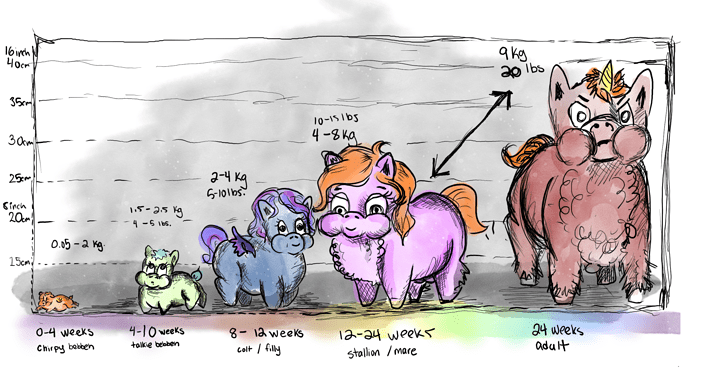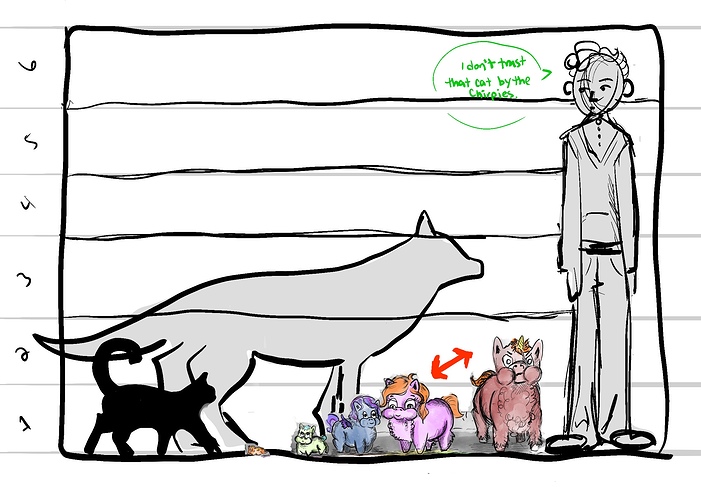Fluffy pony mares can sometimes sense the growth of fetuses hours or even minutes after copulation. Fluffy ponies gestate about forty days. Larger mares with larger litters can sometimes be up to fifty days and require intervention. Dams are often immobilized by the bulk of their pregnant bodies, but not always.
Litters typically less than four foals, but some breeders have reported as many as ten live foals.
Chirpy Bebbeh
The average foal weighs 0.05 kg or about two ounces at birth, small enough to be curled up on a human palm. They consume barely 1/2 a teaspoon or 1.5 ml a day of milk in their first few days, but this number grows exponentially as the chirpy bebbeh grows. A newborn foal who has not doubled their weight by day 7 is at extreme risk of developmental delays.
A foal will communicate with small chirps and peeps and primarily use their sense of smell to navigate, as they are born blind and deaf with sealed eyes and their ears folded close to their heads. A foal will open its eyes at any point during the first 7 days, and the ears will become fully upright any time between birth and adolescence.
The colors of a newborn foal are typically muted, with the colors becoming brighter as their fluff growns in. Horn nubs and wing nubs are often so small they are not visible, depending on the density of the newborn’s fluff.
Dams usually keep their foals and nests very clean, and it is advised not to bathe foals until they have their eyes open and are at least 7 days old unless absolutely necessary.
A foal begins to walk properly with bellies off the ground between 2 and 4 weeks. A foal with open eyes, that can walk and is beginning to form speech is now considered a “Talkie Bebbeh”
Talkie Bebbehs
The second stage of fluffy pony life begins with speech and ambulation. This is the longest and most dramatic phase of fluffy pony development marked by exponential growth. a foal will need to put on 100 grams (3 ounces) a week on average to reach an adult weight of 10 to 15 pounds (8kg) by six months of age when a Fluffy pony reaches maturity.
During this time the colors of the fluff are becoming more vibrant and the wing nubs and horn nubs are visible and developing their own colors as well. wings will begin to sprout feathers. often feathers will have a hard keratin ‘quill’ that can be scratchy, but it is best to let these dry and break away naturally to maximize the growth of the feathers.
During this time it is up to the caregivers to teach the foal to use the litter box, hygeine, and manners. Foals are very active and playful but should be feeding every 3 hours and napping at least 14 hours of the day.
Foals at this age can be curious and develop a dangerous condition called “Splorin bebbeh” where they experience an extreme urge to leave the nest and seek new stimulus. fluffy ponies are fragile and during this phase of rapid growth, talkie bebbehs are at their most fragile and easily injured.
Colt/Filly
At any point between 2 and 4 months a foal will begin to lose interest in milk and want to experiment with solid foods, often only nursing from their mother for comfort and bonding. At this stage of growth a fluffy pony is developing ideas about their social roles and their gender. Foals start to form friendships that will be the foundations of a herd mentality later in life.
between 4 and 6 months a colt or filly will reach adolescence, where they are settling into their adult personalities, societal roles, and when the biological urges begin to surface. Fillies and colts realize they want to have babies and begin seeking out mates, the “special friend.”
It is to be noted that stallions, while physically capable of the act, are not typically fertile until they reach their full adult size.
Fillies being bred too early is extremely dangerous. The immature filly lacks the leg strength to support a stallion on her back, and the hip injuries from being mounted can be a lifelong disability. A filly covered too early and survives to gestation will often be extremely sick, and immobile early in the pregnancy. Most fillies miscarry in the first two weeks, with the small dam often barren from the trauma. A filly able to carry to term will likely suffer from ecclampsia, a dangerous blood pressure condition that causes seizures and death.
Fillies with ecclampsia often have blood pressure that is so high during labor that the force of the contractions causes the uterus to explode. a distended uterus with a large number of fetuses will cause abdominal and pelvic rupture, resulting in a ‘foal-splosion,’ which is almost always fatal for the foals and certain death for the dam.
it is advised that colts and fillies be seperated as soon as they are weaned to avoid injuries and unwanted pregnancies, as sexual maturity can be a difficult milestone to predict in fluffy development.
Adulthood
Adult fluffies reach their full height and weight by 6 months, with slight sexual dimorphism more closely tied to their personality and herd role than gender, per se.
A fluffy can weigh anywhere between ten and twenty pounds, ( 4-9 kg) with an average weight of 12 pounds, or 5kg. The largest fluffies tend to be ‘toughie’ stallions, followed by ‘smarty’ stallions, then ‘toughie’ mares (a rare societal role for a fluffy) and ‘smarty’ mares, with the smallest being ‘poopie’ stallions and mares who don’t typically get above ten pounds due to their… involuntary diet.
The chart above illustrates the rapid growth as well as the diversity of fluffy pony size.
edit: adding!

